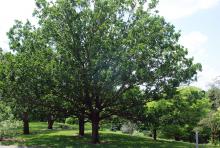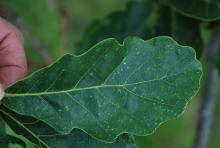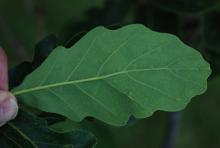Quercus mongolica
Common name:
Mongolian Oak
Pronunciation:
KWER-kus mon-GOL-i-ka
Family:
Fagaceae
Genus:
Type:
Broadleaf
Native to (or naturalized in) Oregon:
No
- Broadleaf deciduous tree, tall, 80-100 ft (~25-30 m) high, in cultivation about 30 ft tall and 25 ft wide (~9 × 7.5 m); young shoots glabrous (without hairs). Leaves alternate, simple, obovate to obovate-oblong, 7-19 cm × 3-11 cm wide, apex obtuse, base tapered and auriculate (ear-like lobes), margin entire, teeth coarse, rounded, upper surface dark green, lighter and glabrous below or pubescent on the veins, leaves densely clustered at shoot tips; petiole 4-8 mm long. Turn brown in fall and stay on the tree into winter. Fruit (nut) ovate, about 2 cm long, nearly sessile (very short stalk), thick cup covers 1/3 of the acorn; mature in one year.
- Sun to part shade. Grows best in fertile loam, but will do well in a wide variety of soils. Drought tolerant.
- Hardy to USDA Zone 3 Native to eastern Siberia, northern China, Korea, and northern Japan; only occasionally found in Mongolia.
- mongolica: of Mongolia






